V.N.S. - Holland Africa Line - The Fontein Ships
- M.S. Randfontein - RIL Nieuw Holland
Please Note: Firefox
and some other Search Engines may not be suitable
Use Google Chrome for this Web Page to load
perfectly!

Click
the logo above to reach the ssMaritime FrontPage for News Updates &
“Ship of the Month”
With
Reuben Goossens
Maritime Historian, Cruise‘n’Ship
Reviewer, Author & Maritime Lecturer
Please
Note: All ssMaritime and other related maritime
sites are 100% non-commercial and privately owned, thus ssmaritime is NOT
associated with any shipping company or any other organisation! Although the
author has worked and been involved in the passenger shipping industry for well
over 60 years, but due to his old age and poor health, he was forced to retire.
Yet, he has completed well over 1,435 Classic Liners, Passenger-Cargo Liners as
well as humble converted C3 converted Migrant Liners, which has transported
countless thousands folk to the new world, as well on vacations’. I trust
the features online will continue to provide Classic Liner and Ship enthusiasts
both the information they are seeking, but more so provide a great deal of
pleasure and relive many happy memories!
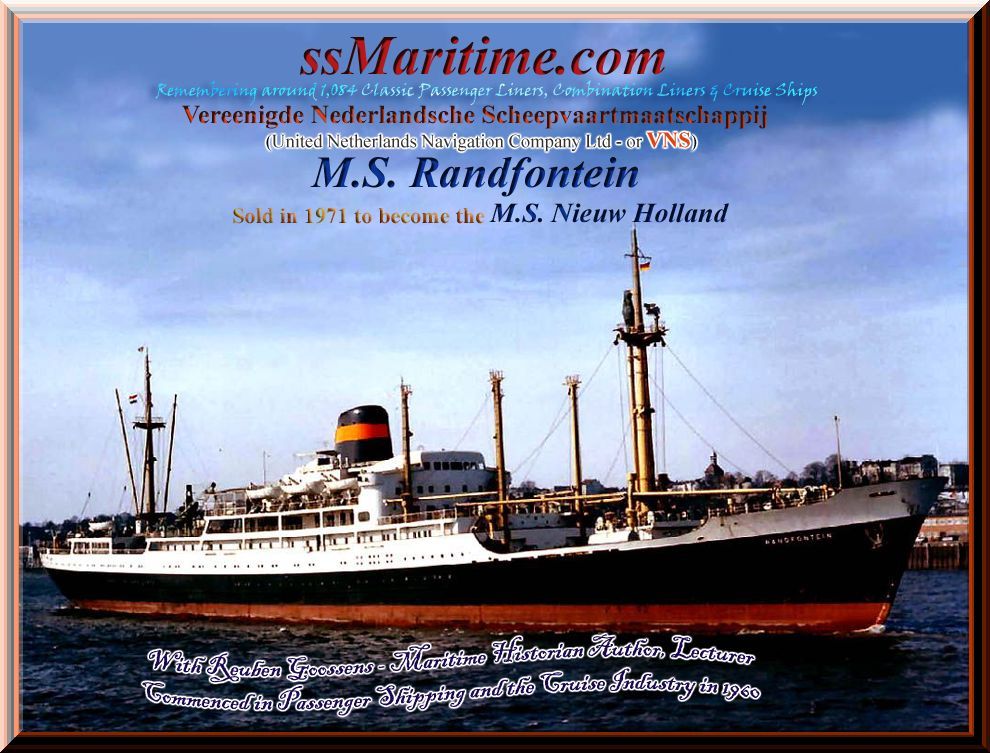
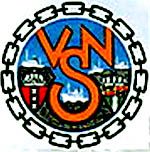
Also known in Dutch & English
as the “Holland Afrika Lijn”
& “Holland Africa Line”
*******************************
Page Three
M.S. Randfontein
To replace the M.S. Klipfontein, which had stuck an unchartered reef of possibly a WW2 sunken
U-Boat an d she rapidly off Mozambique
in 1953, VNS - Holland-Africa Line designed and ordered a
larger and a greatly updated version of the Fontein trio of ships, and this page features this being the last ever V.N.S.
Passenger-Cargo liner!
This new ship would join her two remaining of
two V.N.S. Fontein Trio of ships, the 10,574-ton M.S. Jagersfontein and Oranjefontein
operating on the Netherlands,
UK,
South Africa
and Mozambique
service.

A drawing of MS Randfontein by Mr,
C. E. A. van Boeckel
Drawing
by & © Mr. C.E.A van Boeckel
The new ship was built in a graving dock by
Wilton-Fijenoord at Schiedam
in the Netherlands,
and the 13,694-ton passenger-cargo liner became the largest Holland-Afrika Lijn
liner to be built. Below we see several photographs taken during her
construction.
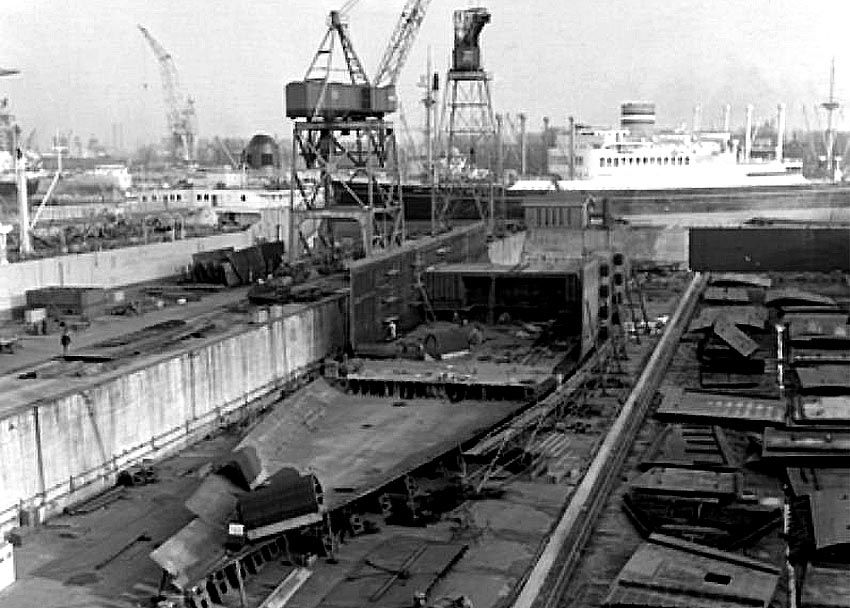
Above & below: The ship seen
during construction in graving dock, Yard 760 in three stages
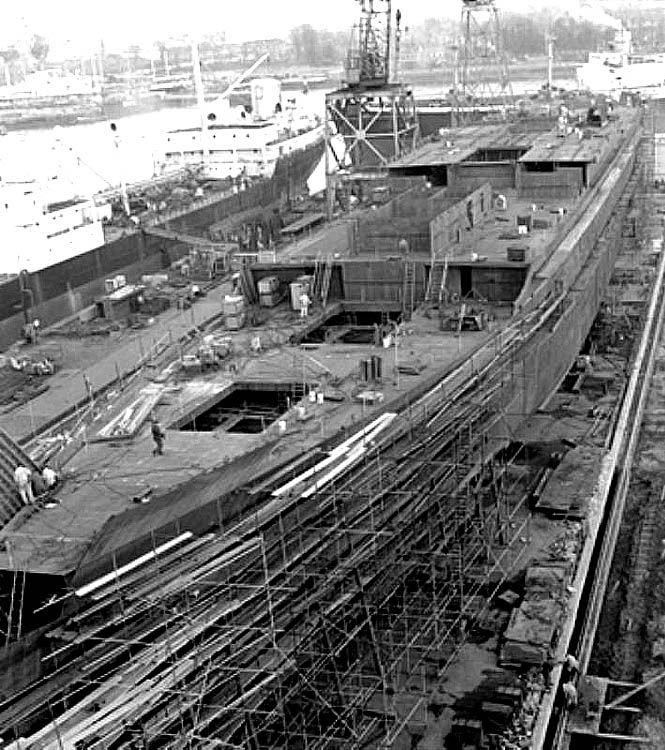
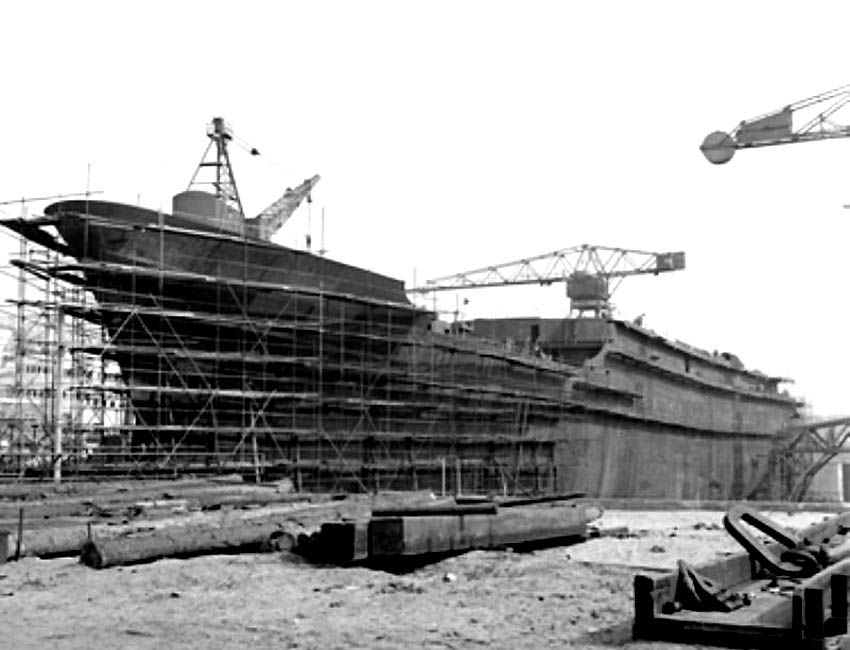
On June 28, 1958, she was
floated out of her graving dock, and was officially named “Randfontein”. The launching was
officiated over by Mrs. Geldenhuys, the wife of the Republic
of South
Africa’s
Ambassador to Den Haag (The
Hague)
she was towed to the builder’s fit-out yards, where she would be
completed and finally one of the last large items was then slowly placed on her
via a large crane was her shapely funnel with topped her with pride and glory.
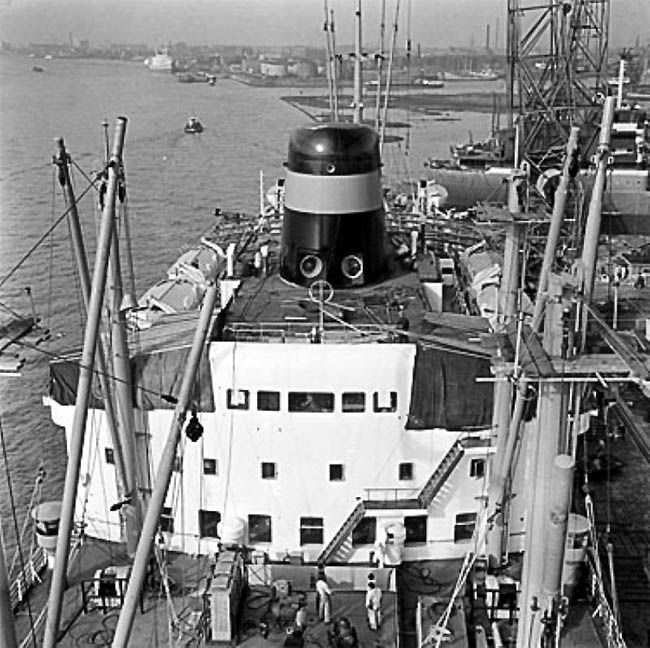
Her funnel has just been fitted and the M.S.
Randfontein nearing completion and will soon be ready for her sea trials
Having successfully completed her speed trials
reaching a good maximum speed of 19.8 knots, and having been completed, the
spotless M.S. Randfontein was handed over to her owners in Amsterdam
on November 24, 1958.
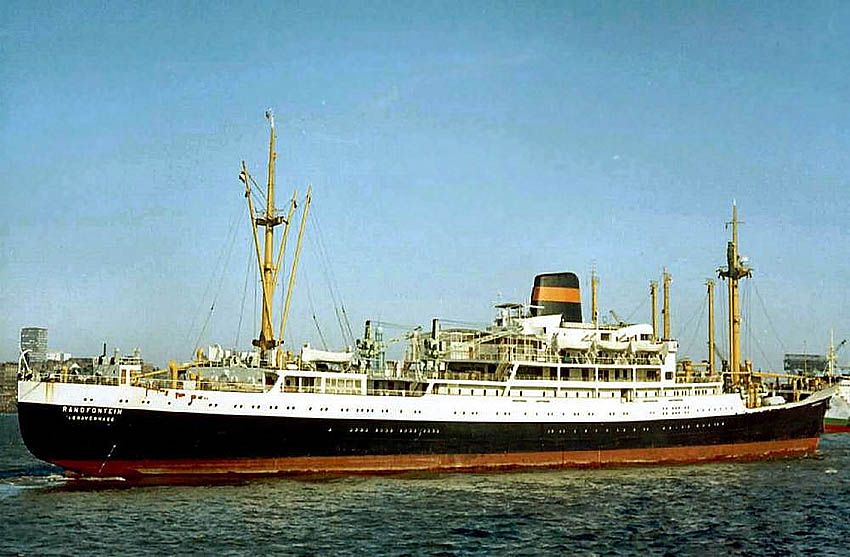
M.S. Randfontein is seen arriving in Amsterdam
Over the next two weeks she was fully crewed,
stocked up and prepared for her voyage to Africa.
Then on January 6, 1959 M.S.
Randfontein looking simply superb and filled with happy passengers and
her holds filled with cargo, departed Amsterdam
for her maiden voyage to Africa,
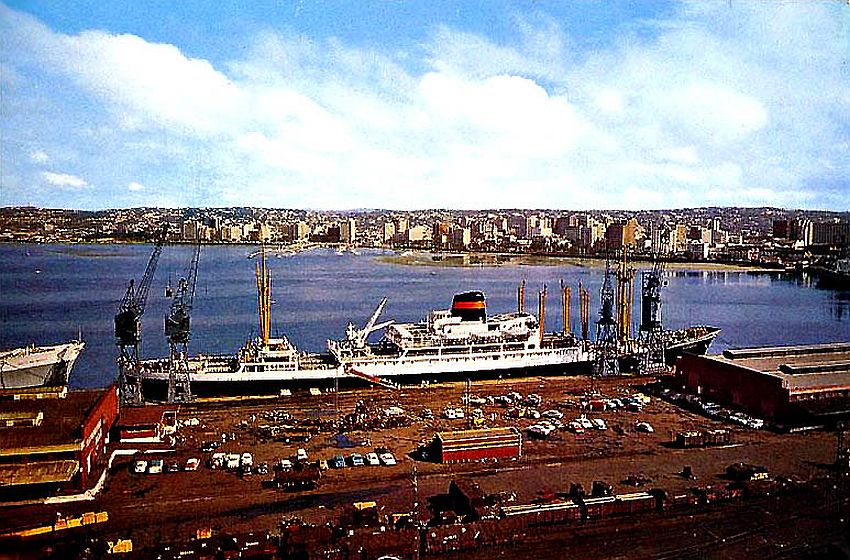
On this V.N.S. postcard the M.S. Randfontein is
seen in Durban,
South Africa
Her regular schedule was as follows: Amsterdam, Southampton, Las Palmas,
Cape Town,
Port Elizabeth,
East London, Durban,
Lourenco and the Marques, and then return, being a service she maintained for
the next eleven years, with the occasional variation.
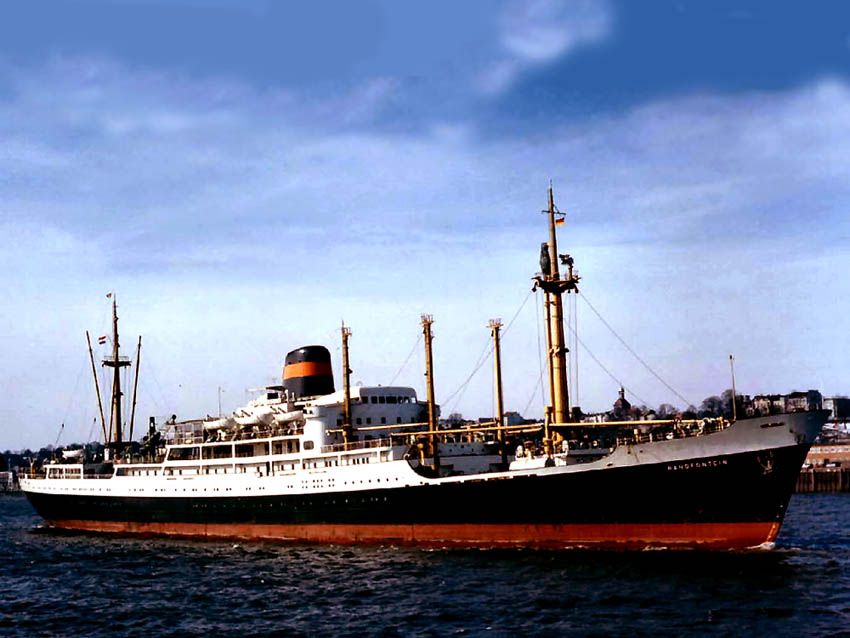
M.S. Randfontein is seen arriving in port
M.S.
Randfontein was designed to accommodate a larger number
of Tourist Class passengers, than the two older Fontein ships. The First Class
cabins were all located on A Deck, being single berth or twin bedded cabins
with all cabins having private facilities. Some cabins had upper Pullmans.
Tourist accommodations offered two, four and several six berth cabins, all with
shared facilities. However, both classes had an excellent number of lounges and
bars, and each class had their own fully tiled swimming pool, which was
virtually unknown in those days for ships of this kind. In
addition there was a children’s Playroom and play deck!
Like her older sisters, the Randfontein had a large cargo
capacity, including refrigerated spaces. Her six holds were distributed, four
forward and two aft. She also had deep tanks to transport vegetable oils.
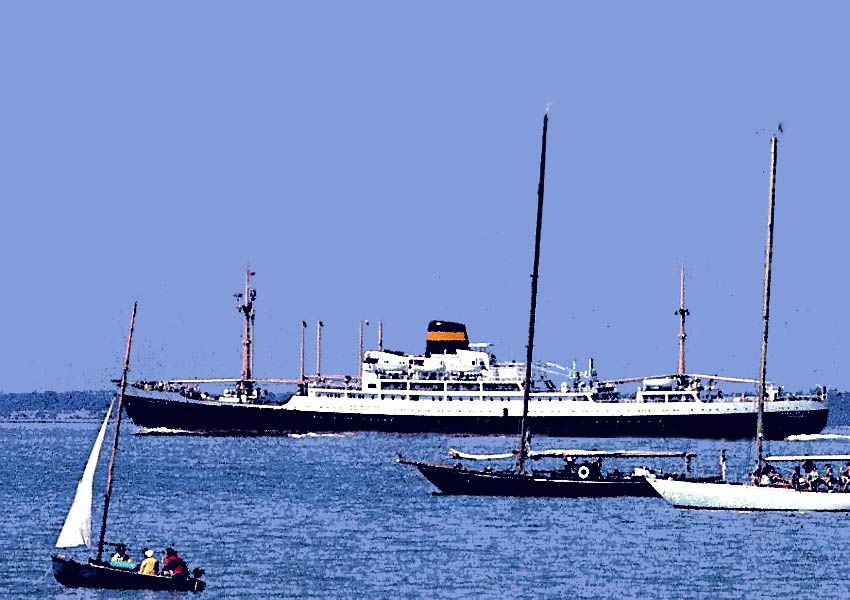
An exceptional photograph of the M.S.
Randfontein seen off the coast of east Africa
Thank you Ineke de
Wijs for sending me this fine photo!
With
the Randfontein having a
boutique typestyle of atmosphere, she rapidly became a popular ship with the
Dutch, English, and European as well as South Africans, thus she enjoyed high
passenger loadings at least until the late sixties.
M.S. Randfontein
Specifications:
Built by:†††††††††††††††††† Wilton-Fijenoord at Schiedam.
Yard:†††††††††††††††††††††† 760.
Length:††††††††††††††††††† 178.3m - 584ft.
Beam:††††††††††††††††††††† 21.4m - 70ft.
Draft:†††††††††††††††††††††† 9.117m - 30.1ft.
Tonnage:††††††††††††††††† 13,694 GRT, 11,765 DWT.
Engines:†††††††††††††††††† 2 M.A.N. Wilton Diesels
(15,400 BHP).
Propellers:††††††††††††††† Two.
Speed:†††††††††††††††††††† 18 knots,
19.8 knots maximum.
Passenger
Decks:†††††† 5.
Passengers:††††††††††††† 289 - 123 First & 166 Tourist
- with some cabins interchangeable).
Later:†††††††††††††††††††††† 297 - 123 First & 174
Tourist - †††††††††††††† “
.††††††††††††††††††††††††††††† Public
venues & first Class Cabins air-conditioned.
Livery:†††††††††††††††††††† Black hull, red boot
topping & white superstructure.††††† ††††††
†††††††††††††††††††††††††††††† Black
funnel with a broad orange band.
She
sailed on and her loading’s remained reasonable until around 1968, but as
with all passenger ships, the much loved M.S. Randfontein in due course also
fell in troubled times as ocean going travel became less and less popular, and
passenger loadings decreased rapidly as did cargo loadings, due to
containerisation.
When she returned to Amsterdam on a day in May
1971, she would not depart again for the company and she was laid up, for it
had already been decided with that V.N.S had to terminate the
Randfontein’s services in May 1971, and dispose of her, which they did!
*******************************
1. M.S. Nieuw Holland 1971 - 1974:
Randfontein was sold to “Royal Interocean Lines” (RIL) in July 1971
they renamed her and quickly dispatched her to Hong Kong
where she was given an extensive refit and external makeover.
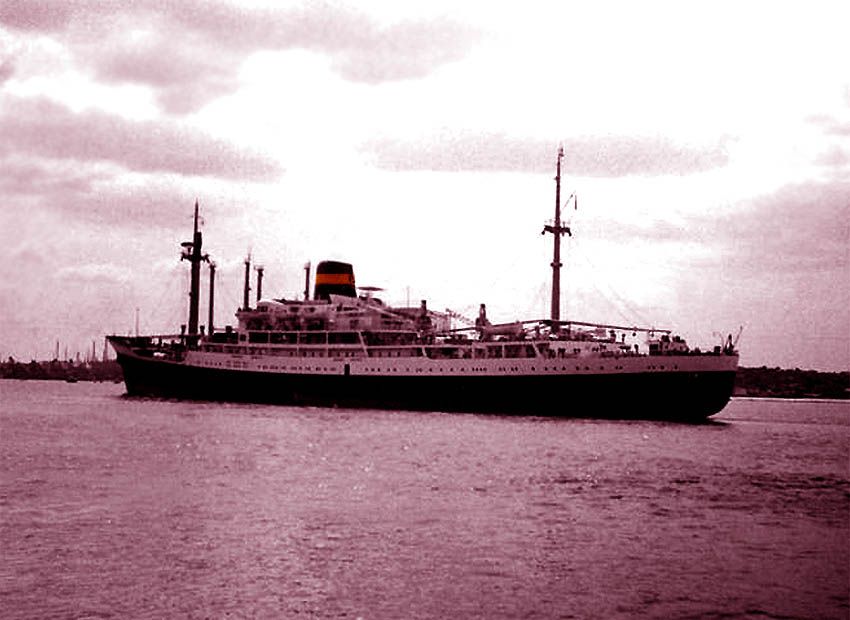
The Randfontein is
seen leaving the Netherlands
bound for Hong Kong and
a new life
Notable external changes were the removal of a
pair of forward derrick posts, being replaced by a large central crane, in
addition her hull was painted white, with green boot topping, and her black
funnel was given the traditional Royal Interocean Lines Dutch Red, white and
blue flag, but in the centre the white section was in the form of a white
triangle with a gold crown, as the company was under “Royal Warrant of
Appointment”. Internally she was also completely refreshed and modernised
and finally she became a fully air-conditioned ship. Upon completion, she now
accommodated a total of 264 passengers with; 122 in First Class and 142 in
Tourist Class. As soon as she was completed, she would depart Japan
and head for Melbourne Australia,
for it would be there her official duties would commence.
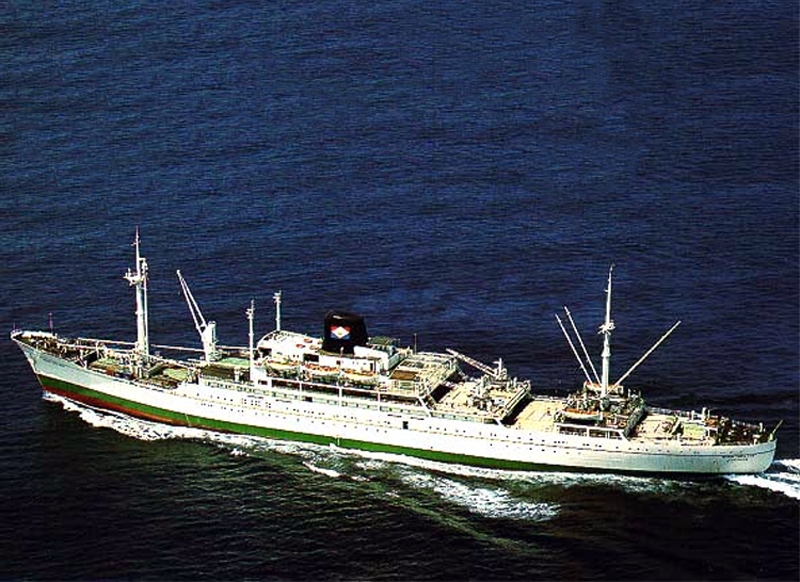
Royal
Interocean
Lines elegant looking M.S. Nieuw Holland,
also note her new forward central located crane
She
departed Hong Kong on her what could be called her delivery voyage to Australia
on January 21, 1972 and she looked a spotlessly smart ship
indeed. From Hong Kong she headed for Brisbane
where she arrived on January 30 and the media came on board to tour the ship,
etc. She departed the next day for Sydney,
where she arrived on February 2. She remained in Sydney
for three-nights for promotional purposes, as she did in Brisbane
and she departed again on January 5 bound for her destination, Melbourne arriving on February 7, 1972 and
she remained there for full week. On Monday February 14, M.S. Nieuw Holland
departed on her maiden voyage to Japan filled with happy passengers, and most
had booked the round voyage.
Her new schedule was as follows: Melbourne, Sydney, Brisbane (Northwards only), Yokkaichi,
Yokohama, Kobe, Hong Kong and Return. This voyage could be taken
sectional to set ports, one way to Yokohama,
or it as a round voyage, a typical cruise.
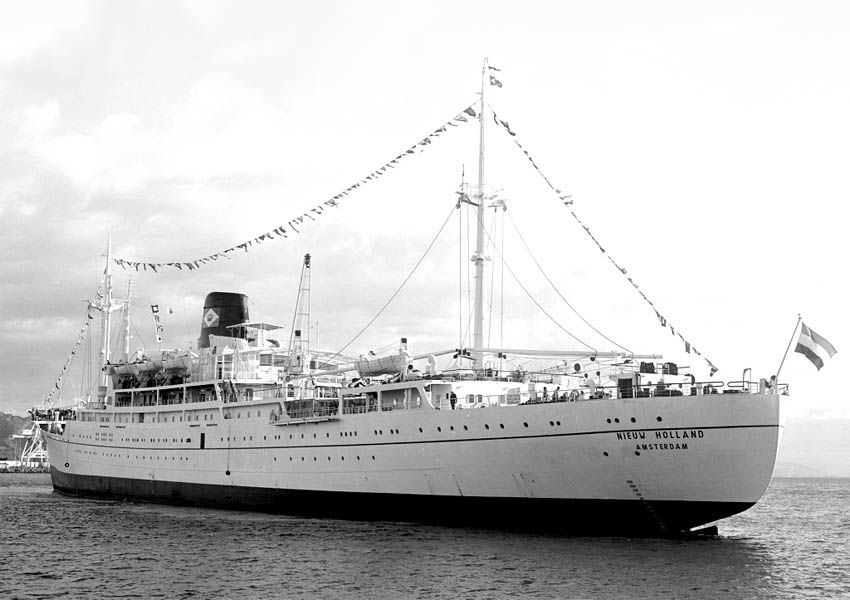
A fine stern view of the RIL M.S. Nieuw Holland
arriving in a port
With RIL now having three RIL major passengers
ships in operation the M.S. Tjiwangi, Tjiluwah, both lovingly known as the
“Elegant White Yachts”, but now the M.S. Nieuw Holland would
replace the Tjiluwah, which was relocated to another service, thus M.S. Nieuw
Holland was partnered by the M.S. Tjiwangi on the Japan service.
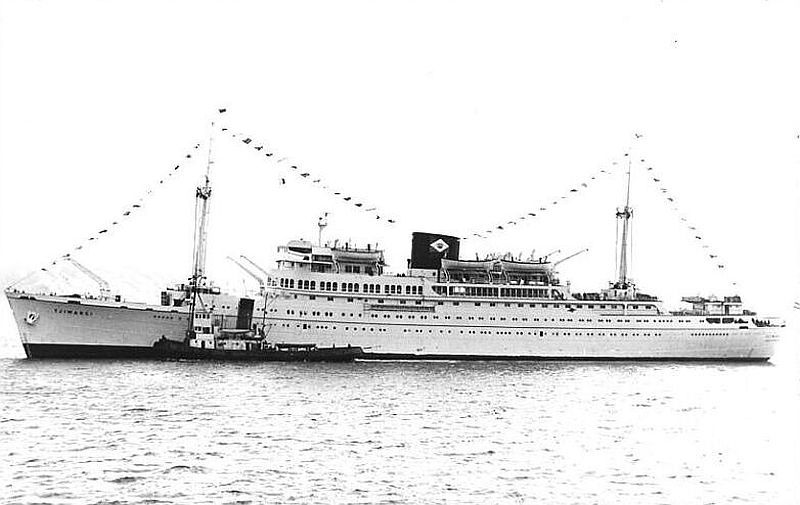
The M.S. Tjiwangi one of the “Elegant
White Yachts”, but soon her sister, the Tjiluwah would be sold
R.I.L. decided to use the M.S. Nieuw Holland
on a cruise to New Zealand,
which would be her first and her last cruise ever. She departed in October
1973, with between *200 to 250 passengers aboard, and she visited Milford
Sound, Dunedin, Wellington
and Auckland returning to Australia. The
company quickly abandoned the idea of using the New Holland as a cruise ship as
they felt that she was just not suitable for the role, thus she returned to the
Australia - Japan service.
The sad truth is that Royal Interocean Lines
had miscalculated the time that shipping was heading in, and the sad fact is
that the Nieuw Holland, which RIL spent a great deal of money on updating her
arrived on the Australia - Japan scene at the wrong time!
Her final Days:
Just as it had been with passenger-cargo ships
for some time there had been a problem with ever declining loadings, and
therefore the smaller M.S. Tjiwangi
was withdrawn from service in 1974, and at the same time hoping to use the M.S.
Nieuw Holland, where she might do
better, she was placed on a new service departing from Adelaide on
February 12, 1974. Her new service was sailing from Adelaide
to Risdon Tasmania, Sydney,
Port Moresby, Bali, Surabaya,
Jakarta, Singapore
arriving on March 10, two days later she continued to Penang, Belawan and Singapore returning to Adelaide,
via Brisbane
instead of Risdon. But this service proved to be a total failure as she made
only four round voyages.
Not only were bookings drying up but also
cargoes were decliningł the truth of the matter was that time had run out for
the larger passenger-cargo ships around the world, including those sailing out
of Australia
to Asia,
we all know this was largely due to cheap charter air fares and cargo
containerisation, as cargo operations had radically changed, and the older
style of handling was slowly becoming out of date.
At the same time, P&O’s S.S. Chitral and Cathay also operated a similar Japan
service as RIL, and P&O, just like the Nieuw Holland were also suffering poor passenger loadings, and
thus both the delightful Chitral
and Cathay
were also taken off the market and both were sold. Sadly, thus the age of these beautiful
and luxurious combination-passenger liners has finally
come to an end.
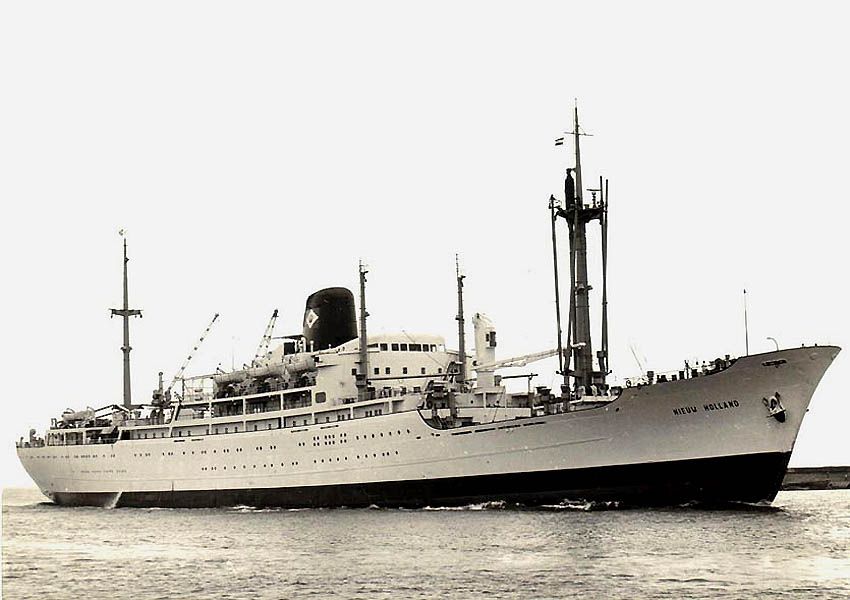
M.S. Nieuw Holland’s days with R.I.L.
were sadly coming to an end
With Royal Interocean Lines (RIL) having been
operating on the Australia
to Asia market for a great deal longer than
most company’s the time had come, that RIL was forced to finally decide,
that they would have to withdraw from this once profitable Australian market
and sell their last ship.
The M.S. Nieuw Holland’s final voyage from Australia saw her depart Sydney on October 22, 1974 being her final
Australian port, and all this happened without any fanfare whatsoever; for
no-one knew she was leaving forever.
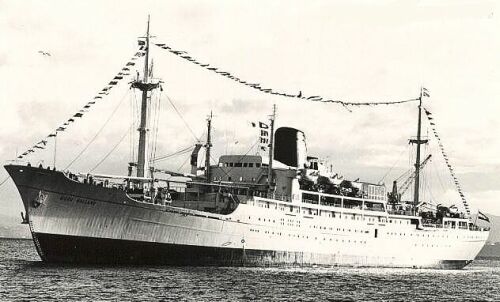
M.S.
Nieuw Holland departs for Japan
This
voyage was a direct service to Singapore and
it was there where
her last ever Royal Interocean Lines passengers disembarked. RIL sent the Nieuw Holland to Hong Kong
without any passengers and upon arrival she was laid
up, and placed on the market and within just several months she was sold.
*******************************
M.S. Yu Hua - Hai Xing 1974 - 1996:
The Nieuw Holland was sold to the Peoples
Republic
of China,
who renamed her M.S. “Yu Hua.” Accommodating
297 passengers and she was registered at 12,191 GRT, and she was placed
on the China-Africa service, but she was later transferred to the Shanghai
- Hong Kong
service. In 1981, M.S. Yu Hua
was transferred to the Shanghai-Hai Xing Shipping
Company, who renamed her “Hai
Xing” but she continued on the Shanghai
to Hong Kong
service for the next ten years.
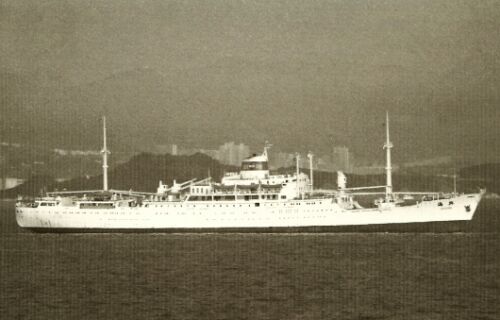
Hai Xing seen here looking very smart in a very
rare photograph taken
in 1990
During her ten
year China-Hong Kong service, I would receive occasional information that she
had been seen in either Shanghai or Hong Kong
and at that she looked a well maintained ship, which was very pleasing to hear
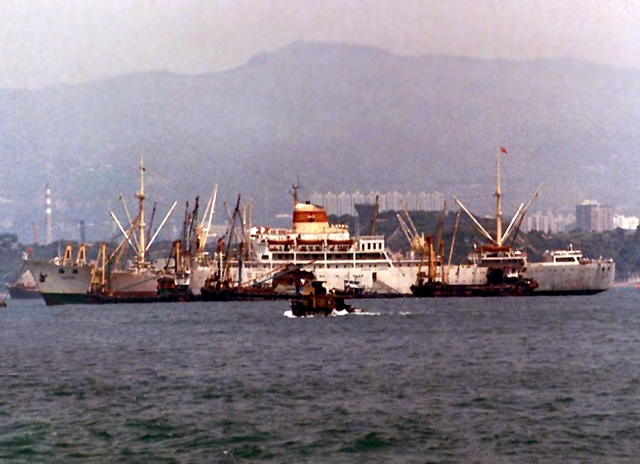
The
M.S. Hai Xing is seen in Hong Kong
Harbour
In 1991, the Hai Xing was finally taken out of service and she was laid up at
Hong Kong,
where she lingered for five years and whilst at anchor, in due course she sadly
deteriorated badly.
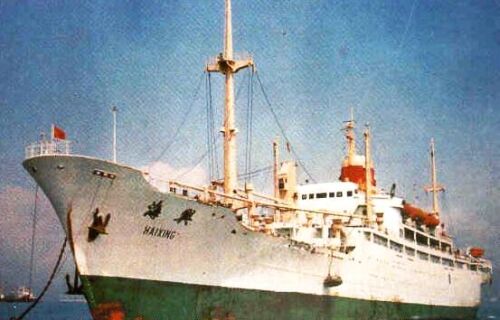
M.S. Hai Xing is seen here laid up at Hong Kong
in the early days in 1991
She was finally sold to Indian breakers in
1996. For her final voyage to India,
she was registered in St Vincent
and renamed “Herbert.”
By now, looking very much the worse for wear, the Herbert, ex Hai
Xing, Yu Hua, Nieuw Holland, and Randfontein departed Hong Kong undertow
by the tug “Redwijs” on May 28, 1996,
and she arrived at Alang,
India
on June 13, and was decommissioned. She was beached four days later and was
rapidly demolished.
The M.S.
Randfontein - Nieuw Holland as a ship that
enjoyed thirty-three years of actual service and five years in her final days
in lay-up, before being broken up. She was sadly the last of a magnificent
series of V.N.S. – Holland Africa Line Fontein
Liners.
*******************************
V.N.S. & Fontein
Ships Index:
Page
One:†††††††††† The Fontein Trio
of Ships history of the M.S. Klipfontein trio of ships
Page
Two:†††††††††† Visser Family
Voyage to South
Africa on the Jagersfontein in 1965.
Page
Three:†††††††† M.S.
Randfontein (2) of 1958
page.
Page
Four:†††††††††† Fontein ships Photo Page memorabilia and brochures, etc.
Also
Read …†††††††† V.N.S.
Freighters from 4 to 12 passengers.
.††††††††††††††††††††††††† SS Abbekerk a delightful V.N.S. 8,336-ton
passenger-cargo ships.
“Blue Water Liners sailing to the
distant shores.
I watched them come, I watched them go and I watched them die.”
****************************
Visit our ssMaritime Main INDEX
Where you
will discover over 1,435 Classic Passenger & Passenger-Cargo Liners!
For interest: Sadly an email
service to ssMaritime is no longer available, due to the author’s old age
and chronic illness as well as being disabled, etc. In the past ssMaritime
received well over 120 emails per day, but Mr.
Goossens can no longer handle the same. He sincerely regrets
this!
ssMaritime.com & ssMaritime.net
Where the ships of the past make history & the 1914 built MV Doulos
Story
The Author has been in Passenger
Shipping & the Cruise Industry for well over 60 years
In addition he was the
founder of “Save the Classic Liners Campaign” in 1990.
Please Note: ssmaritime and associated sites are 100% non-commercial and the
author does not seek funding or favours and never have and never will.
Photographs
on ssmaritime and associate pages are either by the author or from the
author’s private collection. In addition there are some images tographs that have been provided by Shipping Companies or
private photographers or collectors. Credit is given to all contributors,
however, there are some photographs provided to me without details regarding
the photographer or owner concerned. But I have done my best to provide credit
at all times.
ssMaritime is owned & © Copyright by Reuben Goossens - All Rights Reserved




















